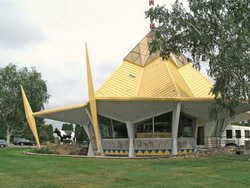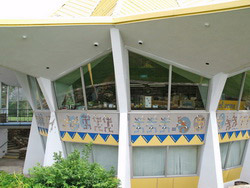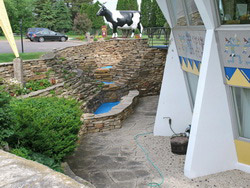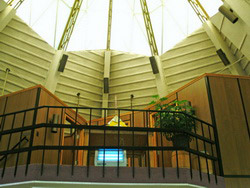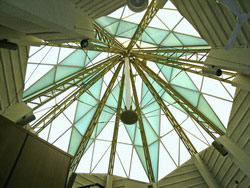1201 East Division Street
| Historic Name: | Wisconsin Pavilion |
|---|---|
| Reference Number: | 12000021 |
| Location (Address): | 1201 East Division Street |
|---|---|
| County: | Clark |
| City/Village: | Neillsville |
| Township: |
| Wisconsin Pavilion 1201 E Division Street (US HWY 10), Neillsville, Clark County Architect: John Steinmann Dates of Construction: 1964, 1966-1967 The Wisconsin Pavilion represented and promoted the State of Wisconsin at the 1964-1965 New York World's Fair in Flushing Meadows, New York. Wisconsin architect John Steinmann designed the pavilion and its surrounding exhibition hall and Pruden Products of Evansville, Wisconsin donated the materials. Being a very late entry, fair officials worried that the Wisconsin entry could not be completed by the opening day deadline; however, they permitted the project to proceed when shown how quickly the steel frames could be erected and how the design would coexist with the futuristic theme of the Fair. Just hours after the fair ended, demolition began. Most of the pavilions were demolished as exhibitors were only given 90 days to remove their structures. Ivan Wilcox and his three sons from Boscobel, along with workmen from Pruden Steel, arrived the day after the fair closed to dismantle the Wisconsin State Pavilion. In 1965, Central Wisconsin Broadcasting purchased the dismantled Pavilion. It was trucked to Neillsville and reassembly began in the summer of 1966 on a five-acre site on the southeastern edge of the city. The new owners hired the original architect, John Steinmann, to provide a cohesive design for its new use as a radio station and gift shop. To gain more square footage, the pavilion was placed on a partially exposed basement. Workmen from Pruden reassembled the building and the company duplicated materials damaged during the deconstruction. As an example of Mid-Century Modernism, the pavilion's design emphasizes the structural system and embraces new materials and new technologies. The development of the steel skeleton, truss systems, and reinforced concrete provided the catalyst for the modern architect to work and meld a building as sculptor molds clay. The development of fiberglass, steel and aluminum sheeting and a stronger glass panel allowed for new and innovative treatments of flat surfaces. Prefabrication also influenced architectural design and allowed the architect to experiment with new forms and shapes. Further, the pavilion is an example of the desire of states and countries to both promote and participate in fairs and exhibitions and the interest of individuals and organizations to collect and reuse fair buildings after the end of the exhibition. The Wisconsin Pavilion represents one of the few extant resources associated with Wisconsin's statewide representation at a world's fair or exhibition and the only state pavilion that has returned to the state. The building is open to the public during regular business hours. |
| Period of Significance: | 1964-1967 |
|---|---|
| Area of Significance: | Architecture |
| Area of Significance: | Social History |
| Applicable Criteria: | Event |
| Applicable Criteria: | Architecture/Engineering |
| Historic Use: | Recreation And Culture: Fair |
| Architectural Style: | Modern Movement |
| Resource Type: | Building |
| Architect: | Steinmann, John |
| Historic Status: | Listed in the National Register |
|---|---|
| Historic Status: | Listed in the State Register |
| National Register Listing Date: | 02/14/2012 |
| State Register Listing Date: | 11/19/2010 |
| Number of Contributing Buildings: | 1 |
|---|---|
| Number of Contributing Sites: | 0 |
| Number of Contributing Structures: | 0 |
| Number of Contributing Objects: | 1 |
| Number of Non-Contributing Buildings: | 0 |
| Number of Non-Contributing Sites: | 0 |
| Number of Non-Contributing Structures: | 0 |
| Number of Non-Contributing Objects: | 0 |
| National Register and State Register of Historic Places, State Historic Preservation Office, Wisconsin Historical Society, Madison, Wisconsin |

